In its news release at the beginning of this year, Itaipu Binational announced a unique development in the energy sector.
Central HidroeléctricaItaipú, operated by this company on the border of Paraguay and Brazil, reached a colossal 2.77 billion MWh of accumulated electricity production by the end of 2020, which has not been achieved by any other energy plant in the world.
Itaipu Binational is, therefore, a world leader in clean and renewable energy generation. The Itaipu Dam is not the largest hydroelectric power plant.
The installed capacity of China's Three Gorges is significantly higher – 22500 MW compared to 14,000 MW of the South American hydro plant.
Itaipu Dam - aerial view. Credit I.Ciorici
Nevertheless, Itaipu Dam has been producing over 90 million MWh annually for many years, with a peak of over 103 million MWh in 2016. In 2020, the Chinese plant, relying among other things on the experience of its South American colleagues, managed to generate an incredible record of 111.8 million MWh, but so far it is inferior to the Itaipu Dam in terms of accumulated electricity production.
The history of Itaipu Dam began 55 years ago in 1966, when the Foreign Ministers of Brazil and Paraguay signed the Act of Iguacu to build a dam on the border river Parana.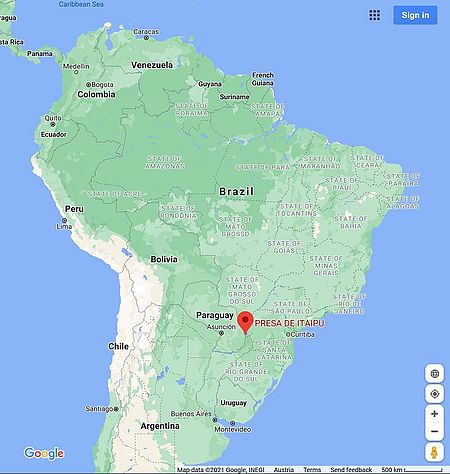
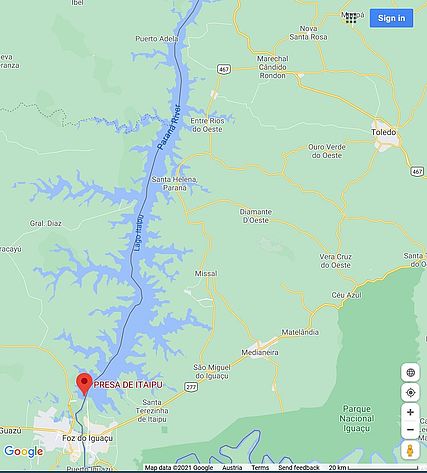
Location of Itaipu Dam on Google map
Five years later in February 1971, topographical and geological exploration began in this region, so that today we can talk about the fiftieth anniversary of the beginning of the actual construction of this hydroelectric power plant.
Itaipu Dam. Credit I.Ciorici
In May 1984 the construction of Itaipu Dam was completed at a cost of about 20 billion dollars and the plant began generating electricity.
The dam is 196 meters high and over 7,200 meters long. The reservoir formed by the dam has a flooded area of 1,350 km2 and is 170 km long, having one of the best water use coefficients – more than 10 MW per km2. The hydropower plant consists of 20 power units of 700 megawatts, each capable of passing 160 tons of water per second.
Pressure pipelines at Itaipu Dam (penstock). Credit I.Ciorici
Today, Itaipu provides more than 10% of the energy used in Brazil and almost 90% of the energy used in Paraguay. The transmission system distributing the electricity generated by Itaipu Dam between the 50 Hz (for Paraguay) and 60 Hz (for Brazil) substations consists of several 500 KV transmission lines. The main end users of electricity are the densely populated areas of São Paulo and Rio de Janeiro in Brazil.
In addition to the main dam for power generation, Central HidroeléctricaItaipú includes a giant spillway dam for discharging the reservoir and diverting water not utilized for generation. According to Itaipu Binational, the discharge capacity of the spillway exceeds 60,000 m3/s.
According to the company's statistical reports, in recent years the operational capacity factor of Itaipu Dam has been 96.2-99.8%, which clearly demonstrates the highest level of operational efficiency.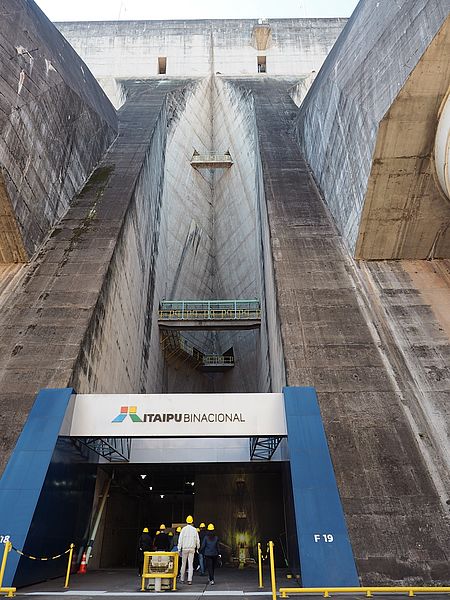
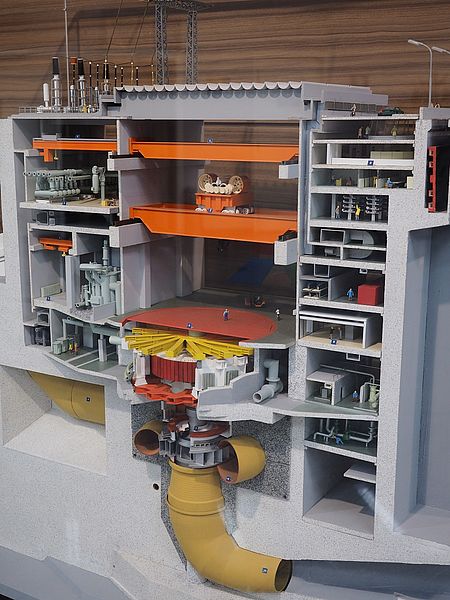
Internal dam structure. Credit I.Ciorici
Itaipu Binational. Power station control room. Credit I.Ciorici
In 1994 the American Society of Civil Engineers (ASCE) listed Itaipu Dam among seven wonders of the Modern Industrial World, along with such famous constructions as the Panama Canal or the Empire State Building in New York.
The Itaipu area is a unique neighborhood of modern energy industry and a rich natural ecosystem, attracting many tourists, scientists, and students, to which Itaipu Binacional also pays great attention. Besides the hydropower plant, there is the famous Iguazu National Park with its unique South American flora and fauna, and the chain of Iguazu waterfalls. Of course, during the COVID-19 pandemic, mentioning this seems untimely, but as King Solomon said, "Everything goes by, and this too shall pass." And when everything goes back to normal, Itaipu will surely be even more popular.
The support of the region's ecosystem by a reputable industrial company, such as Itaipu Binacional undoubtedly creates the important positive experience that such heterogeneous objects of modern society can coexist.
Iguazu Falls. Credit I.Ciorici
Some significant facts about the cooperation are worth mentioning: “over 44 million seedlings, equivalent to 100 thousand hectares or 60% of the Iguazu National Park area” have been planted in the past 40 years; 98% of the reservoir is protected by a vegetation strip; in the national park there are Itaipu's Eco-museum and an extensive veterinary hospital for local animals.
Iguazu Falls and rainbow. Credit I.Ciorici
Iguazu Falls. Harpy eagle in flight. Credit I.Ciorici
The main attraction of the Iguazu National Park is, of course, the Iguazu Falls, which consists of about 300 individual waterfalls. They are located on the Iguazu River, which separates Brazil and Argentina, about 30 km from the confluence of this river into the Parana River downstream from the hydro station. The total width of the waterfalls exceeds 2.7 km and the height reaches 75 m. Iguazu Falls are recognized as a UNESCO World Heritage Site, and many consider this network of waterfalls to be the largest in the world.
South American coatis are the most famous mammals of Iguazu. Credit I.Ciorici
Iguazu National Park hosts a great variety of plants, animals, and birds. Be prepared to meet members of the raccoon family South American Coatis. If you are lucky you may also see giant anteaters, red brocket deers, jaguars, ocelots and many other rare animals. Among the many birds, the toco toucan and chestnut-eared aracari are particularly graceful.
For more information about the biodiversity of Iguazu National Park, visit the aforementioned Eco-museum. Here you will also be told about the history of the development of the power plant, as well as offered activities for environmental education.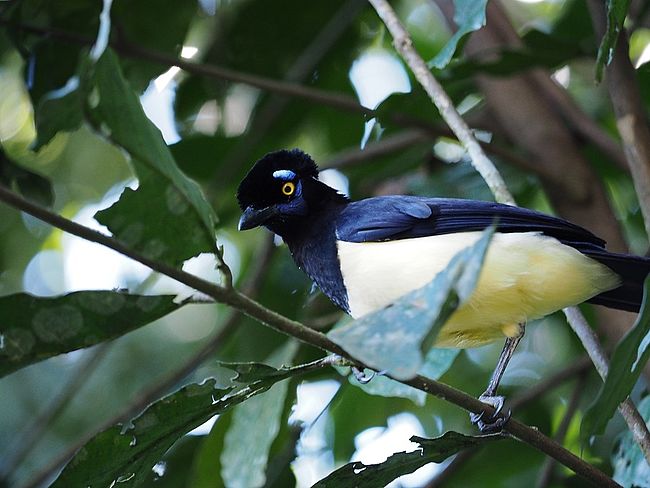
Iguazu.Plush-crested jays. Credit I.Ciorici
